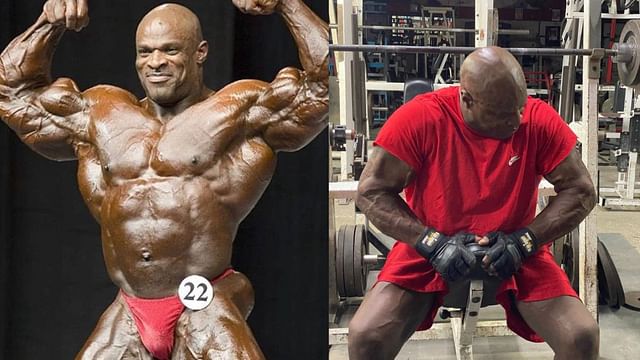Physical Address
304 North Cardinal St.
Dorchester Center, MA 02124
Physical Address
304 North Cardinal St.
Dorchester Center, MA 02124

Ronnie Coleman, a name synonymous with strength and resilience, dominated the bodybuilding world in the late 1990s and early 2000s. Known for his record-breaking performances, such as the jaw-dropping 800-pound squat, Coleman secured the prestigious Mr. Olympia title eight times, earning him the nickname “The King.” Despite his fame and success, Coleman’s presence in the public eye diminished post-retirement, leading many to wonder, “What happened to Ronnie Coleman?”
Born on May 13, 1964, in Bastrop, Louisiana, Coleman’s initial career aspirations were far from the bodybuilding stage. After playing college football as a middle linebacker at Grambling State University under coach Eddie Robinson, he graduated with a degree in accounting. However, the competitive job market left him without a position in his field, leading him to take a job at Domino’s Pizza to make ends meet. This unexpected turn of events was just the beginning of a remarkable journey that would eventually lead him to become a police officer in Arlington, Texas, from 1989 to 2000, and later, a bodybuilding icon.
While serving as a police officer, Coleman didn’t give up on his passion for bodybuilding. Balancing his law enforcement duties with rigorous training, he began to make a name for himself in the bodybuilding community. His big break came when a fellow officer introduced him to Metroflex Gym, owned by amateur bodybuilder Brian Dobson. Dobson saw potential in Coleman and offered him a free lifetime gym membership in exchange for training him for the upcoming 1990 Mr. Texas competition, which Coleman won, marking the start of his professional bodybuilding career.
Despite a rocky start at the 1992 Mr. Olympia, where he finished outside the top 15, Coleman’s persistence paid off. He returned to the Olympia stage in 1994, and by 1995, he had secured his first professional win at the Canada Pro Cup. His career trajectory continued upward, culminating in his first Mr. Olympia title in 1998, a title he would defend successfully seven more times. Throughout his career, Coleman was known for his incredible strength and dedication, often performing astonishing feats of strength during his training sessions, which were later featured in his popular workout videos.
Coleman’s approach to training was characterized by his preference for free weights over machines, believing that free weights offered better flexibility and range of motion. His training videos, such as “The Unbelievable,” “The Cost of Redemption,” and “On the Road,” provided insights into his training philosophy and techniques, emphasizing the importance of proper form and the risks of overexertion.
His diet was just as rigorous as his training regimen. Coleman’s nutritional plan was high in protein, which he believed was essential for muscle growth, constituting about 65% of his diet. His daily routine included multiple protein shakes and carefully planned meals to optimize his performance and physique. In addition to his strict diet, Coleman took various supplements to support his intense training regimen and maintain his health during the peak of his bodybuilding career.
Despite his success, the physical demands of bodybuilding took a significant toll on Coleman’s body. After his last competition at the 2007 Mr. Olympia, he faced severe back pain that had been bothering him for over a decade. Initially reluctant to undergo surgery, Coleman eventually had to face multiple spinal surgeries that unfortunately did not resolve his pain issues. These surgeries, coupled with double hip replacements and ongoing back issues, have dramatically affected his mobility and quality of life.
In recent years, Coleman has been open about his health struggles, sharing details of his surgeries and the impact they have had on his body. Despite these challenges, he remains dedicated to his fitness, adapting his workouts to accommodate his physical limitations and continuing to inspire others with his resilience and determination.
1. How many times did Ronnie Coleman win Mr. Olympia?
Ronnie Coleman won the Mr. Olympia title eight consecutive times from 1998 to 2005.
2. What is Ronnie Coleman’s training philosophy?
Coleman preferred using free weights over machines to enhance flexibility and range of motion. He emphasized the importance of proper form and avoiding overexertion.
3. What kind of diet did Ronnie Coleman follow?
His diet was high in protein, with protein making up about 65% of his intake. He also consumed a balanced amount of carbohydrates and fats and took various supplements.
4. What surgeries has Ronnie Coleman had?
Ronnie Coleman has undergone multiple surgeries, including spinal surgeries, double hip replacements, and procedures to address complications from previous surgeries.
5. Does Ronnie Coleman still work out?
Yes, despite his health issues, Ronnie Coleman continues to work out, adapting his routine to accommodate his physical limitations.
6. What is Ronnie Coleman doing now?
Ronnie Coleman remains active in the fitness community, runs a successful nutritional supplement line, and continues to inspire and motivate people around the world with his story.
Ronnie Coleman’s journey through bodybuilding and beyond is a testament to his incredible strength, both physical and mental. Despite the setbacks and challenges, his legacy in the bodybuilding world remains unparalleled, and his story continues to inspire athletes and non-athletes alike.


